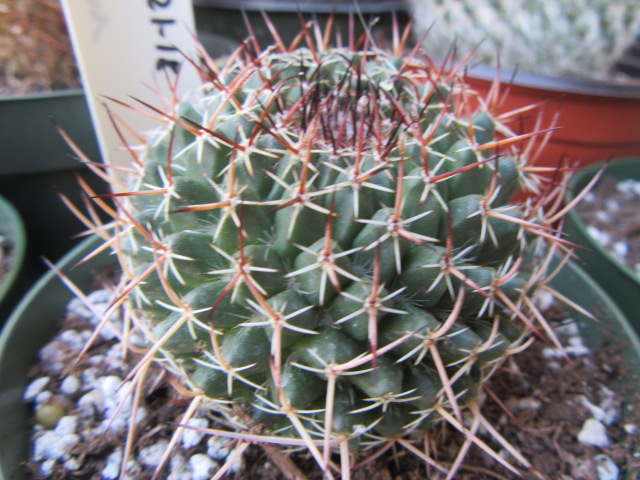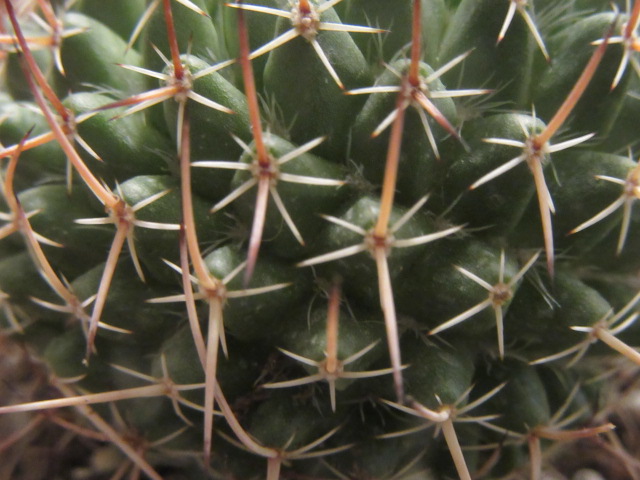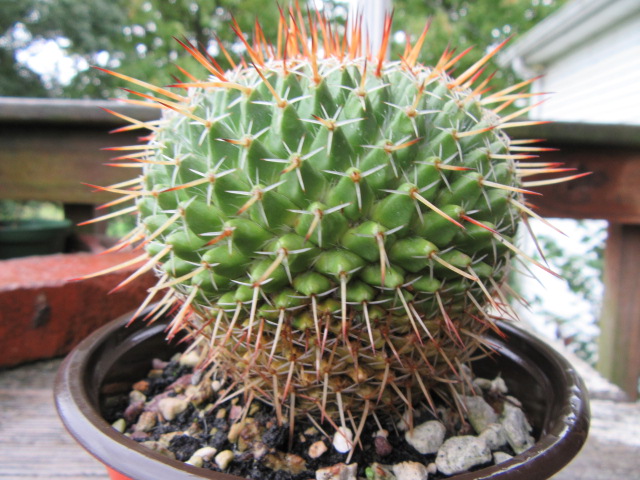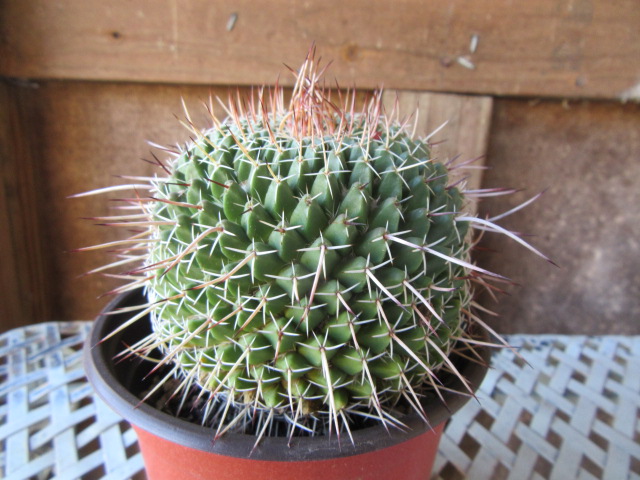
Mammillaria mystax after I bought it home on 9-21-18, #510-14.
Mammillaria mystax
mam-mil-AR-ee-uh MY-staks
Synonyms of Mammillaria mystax (32) (Updated on 12-8-23 from Plants of the World Online): Cactus funkii (Scheidw.) Kuntze (1891), Cactus leucotrichus (Scheidw.) Kuntze (1891), Cactus maschalacanthus (Monv. ex Labour.) Kuntze (1891), Cactus mutabilis (Scheidw.) Kuntze (1891), Cactus mystax (Mart.) Kuntze (1891), Cactus xanthotrichus (Scheidw.) Kuntze (1891), Mammillaria atroflorens Backeb. (1962), Mammillaria autumnalis A.Dietr. (1848), Mammillaria casoi Bravo (1954), Mammillaria crispiseta R.T.Craig (1945), Mammillaria erythra Repp. (1987), Mammillaria erythra f. ruber Repp. (1987), Mammillaria funkii Scheidw. (1841), Mammillaria huajuapensis Bravo (1954), Mammillaria leucocarpa Scheidw. ex Salm-Dyck (1850), Mammillaria leucotricha Scheidw. (1840), Mammillaria maschalacantha Monv. ex Labour. (1853), Mammillaria maschalacantha var. leucotricha (Scheidw.) Monv. ex Labour. (1853), Mammillaria maschalacantha var. xanthotricha (Scheidw.) Monv. ex Labour. (1853), Mammillaria meschalacantha Salm-Dyck (1845), Mammillaria mixtecensis Bravo (1954), Mammillaria mutabilis Scheidw. (1841), Mammillaria mutabilis f. autumnalis (A.Dietr.) Schelle (1926), Mammillaria mutabilis var. laevior Salm-Dyck (1845), Mammillaria mutabilis var. leucocarpa Schelle (1907), Mammillaria mutabilis var. leucotricha Schelle (1907), Mammillaria mutabilis var. xanthotricha (Scheidw.) Salm-Dyck (1850), Mammillaria mystax var. huajuapensis (Bravo) Linzen (1991)(no basionym ref.), Mammillaria senkii C.F.Först. (1846), Mammillaria xanthotricha Scheidw. (1840), Mammillaria xanthotricha var. laevior Salm-Dyck (1845), Neomammillaria mystax (Mart.) Britton & Rose (1923)
Mammillaria mystax Mart. is the accepted scientific name for this species. It was named and described by Carl (Karl) Friedrich Philipp von Martius in Hortus Regius Monacensis in 1829.
The genus, Mammillaria Haw., was named and described by Adrian Hardy Haworth in Synopsis Plantarum Succulentarum in 1812.
As of 12-8-23 when this page was last updated, Plants of the World Online by Kew lists 138 species in the Mammillaria genus. It is a member of the plant family Cactaceae with 150 genera. Those numbers could change as updates are made on POWO. The number of species in the genus and genera in the family fluctuates off and on.
THERE ARE SEVERAL LINKS AND GROWING RECOMMENDATIONS AT THE BOTTOM OF THE PAGE FOR FURTHER READING.

Mammillaria mystax on 9-21-18, #510-15.
I bought this plant from Lowe’s on clearance on September 21, 2018. The Mammillaria mystax is another Owl’s Eye Cactus that divides dichotomically. The label says:
“A globular cactus, usually solitary and growing to 6” in height and sometimes to 8” in diameter. Spine color is highly variable with whitish wool and bristles at axils. Rings of reddish-violet flowers appear in April and May. Native of Oaxaca, Mexico. Protect from frost. Provide bright light/sun; hardy to 20° F. Water thoroughly when soil is dry.”
The plant was growing in a 4 oz. (2 1/2” diameter x 2 1/4” tall) pot. The plant measured approximately 1 3/4” tall x 2 1/4” wide without the spines.

Mammillaria mystax from the top on 9-21-18, #510-16.
Mammillaria mystax is native to the highlands of south-central Mexico around Puebla, Guerrero, and Oaxaca at around 3,280-8,500 feet (1,000-2,600 meters) above sea level. It occurs in tropical dry deciduous forests and scrubland along with many other genera and species of cactus.
Mammillaria mystax is a neat small cactus with very pronounced pyramid-shaped tubercles. In the wild, it produces very long, entangled spines on its crown but that seldom happens in cultivation. This species divides dichotomously as well as possibly producing offsets. It will produce a ring of rose flowers with brown mid-veins in up to 3 rows.

Mammillaria mystax on 10-10-18, #519-48.
I had to move the potted plants inside for the winter on October 10 because the forecast was calling for an “F” in a few days and the nighttime temperatures were getting cooler. I usually measure the cactus and succulents when I bring them inside, but I didn’t measure this one because I measured it when I brought it home in September.

Mammillaria mystax on 11-29-18, #535-22.
November 29 was a nice spring-like day, so I took the cactus to the back porch for a photoshoot. I was working on a post to show the difference between the cactus in my collection.

Mammillaria mystax close-up on 12-1-18, #535-17.
This close-up reveals many areoles with two central spines and up to six radial spines… In later photos, and upon taking a closer look, I could only find 4-5 radial spines and 1 central spine…
<<<<2019>>>>

Mammillaria mystax on 6-22-19, #593-31.
Once evening temperatures warmed up enough I moved the potted plants back outside for the summer. The cacti were moved to the back porch to receive full sun.
I was fairly busy during the summer so I didn’t take as many photos as usual. Despite a little neglect, the plants all did very well.

Mammillaria mystax at 2 1/4″ tall x 2 1/2″ wide on 10-11-19, #639-67.
The next thing I knew I had to move the potted plants inside for the winter on October 11 because an “F” was in the forecast. I always take photos of all the plants as I move them inside and measure the cactus and some of the succulents. The Mammillaria mystax measured 2 1/4″ tall x 2 1/2″ wide (without the spines). It measured 1 3/4″ tall x 2 1/4″ wide when I brought it home on 9-21-18.

Mammillaria mystax from the top on 10-11-19, #639-68.
Mammillaria mystax has very prominent 4-6 angled pyramid-shaped tubercles, as many as 34 rows, lined in a spiral pattern. Areoles around the apex of the plant have a small amount of wool but appear to be absent on the rest of the areoles. The plant’s axils (the area between the tubercles) also have a small amount of wool and hair (depending on where you look).
Areoles produce 3-10 small white radial spines, some with dark tips. The central spines are a different story… Information states Mammillaria mystax can have 3-4 central spines, but sometimes they may have only one. They begin as a purplish-brown at the apex (top of the plant) but turn a grayish color (some with brown tips). With my plant, some of the smaller central spines below the midpoint are also brownish. For the most part, my plant has 4-5 radial spines and 1 central spine of varying lengths. I noticed many areoles with 2 central spines in earlier photos but they appear to have disappeared…
<<<<2020>>>>

Mammillaria mystax at 2 3/4″ tall x 2 3/4″ wide on 10-15-20, #747-73.
I had to bring the potted plants inside on October 15 in 2020 because an “F” was in the forecast’. As usual, I took photographs as I brought the plants inside. I always measure the cactus and some of the succulents. The Mammillaria mystax did very well over the summer and measured 2 3/4″ tall x 2 3/4″ wide at the time. That’s pretty good since it was 1 3/4″ tall x 2 1/4″ wide when I brought it home on September 21, 2018.

Mammillaria mystax from the top on 10-15-20, #747-74.
I always like looking at the top of the cactus. The above photo is a good example of how the central spines at the apex of the plant are purplish-brown and change color as the plant grows. The radial spines are a whitish color and much smaller than the central spines. Of course, the spines are very sharp…
<<<<2021>>>>

Mammillaria mystax at 3 1/8″ tall x 3 1/4″ wide on 10-28-21, #853-19.
I didn’t have to move the potted plants inside for the winter until October 28 in 2021. There wasn’t a chance of “F” in the forecast until then which was quite unusual. The Mammillaria mystax did very well and grew to 3 1/8″ tall x 3 1/4″ wide.
USEFUL INFORMATION:
Family: Cactaceae
Origin: South Central Mexico
Zones: USDA Zones 9a-11 (20-40° F)
Size: 6-12″ tall. Different websites have different information.
Light: Sun to part shade
Soil: Very well-draining. Potting soil amended with pumice or perlite and grit.
Water: Regular watering during the summer and barely to none during the winter.
You can read my Cactus Talk & Update and Cactus & Succulent Tips to get my opinion about growing cacti and succulents.
When you bring your new plants home from the store, you need to check their roots and the soil to see if they are wet. If so, you may want to re-pot it right away. It is advisable to re-pot them in a better potting soil that is more suitable for cacti and succulents.
<<<<2022>>>>

Mammillaria mystax at 2 3/4″ tall x 3 1/8″ wide on 10-16-22, #919-27.
Very funny… I had to move the potted plants inside for the winter on October 16 in 2022 because an “F” was in the forecast. The Mammillaria mystax shrunk! The measurement from last year was 3 1/4″ tall x 3 1/4″ wide and now it is 2 3/4″ tall x 3 1/8″ wide. Heck, it was 2 3/4″ tall in 2020. It has grown quite a bit, though, since it was just 1 3/4″ tall x 2 1/4″ wide when I brought it home in 2018. Sometimes that happens with cacti when they don’t have enough water. That is likely the case since they were under the roof of the front porch and most of the time just received rain as it blew in on them. I am not complaining that it shrunk especially since it is partly my fault. OK, it was likely all my fault. But, it was safe from the scorching sun on the front porch which I know it appreciated. How do I know? Well, it was smiling at me when I measured it and took its photo. Of course, I could have mismeasured last year…
<<<<2023>>>>

Mammillaria mystax at 3 1/2″ tall x 3 1/4″ wide on 10-23-23, #967-28.
Even though there was no “F” in the forecast until October 30, it was going to be a rainy week so I moved the potted plants inside on the 23rd and 24th. Time for photos and measurements…
The Mammillaria mystax did very well during the summer on the back porch in full sun despite the heat and drought. It measured 3 1/2” tall x 3 1/2” wide when I moved it inside for the winter.
The Mammillaria mystax is a great cactus and I enjoy having it as a companion. It is just weird it doesn’t have a common name. I will continue adding more photos and information as time goes by. Be sure to click on the link to Llifle below for further reading.
There isn’t a whole lot of information online about the Mammillaria mystax but hopefully, someday there will be more.
I hope you enjoyed this page and maybe found it useful. I would like to hear from you if you have any comments, questions, or suggestions. Please click on “like” if you visited this page. It helps us bloggers stay motivated. 🙂 You can check out the links below for further reading. The links take you directly to the genus and species of this plant.